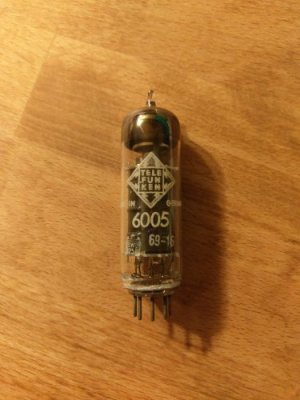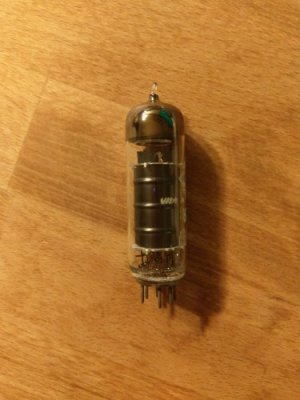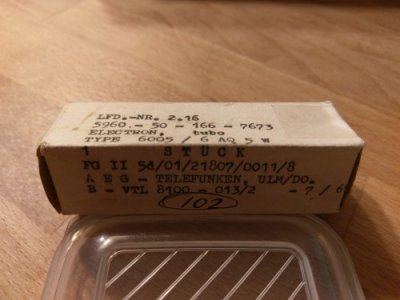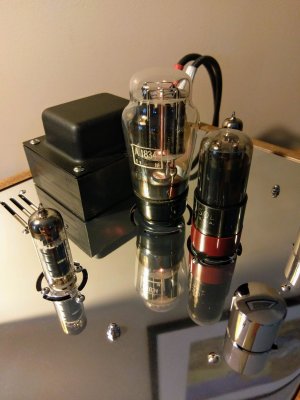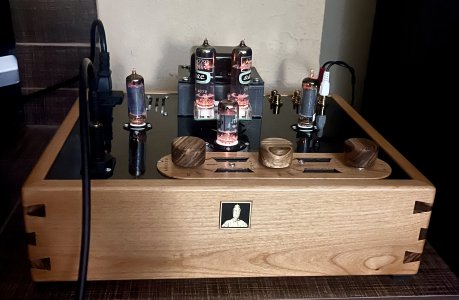So, almost four months later, I finally found some time to sit down and do a comparison of the 6AQ5/6005 tubes I have on hand.
My Audio chain:
Lossless FLAC via Foobar2000 > Topping D50 DAC > customized Crackatwoa (Sylvania 6SN7W short bottle driver, Tung Sol 421A power tube) > ZMF Auteur > my head. Everything is plugged into a Furman PST-8D power conditioner and my DAC is linear power supplied, because, unfortunately, I am insane.
Here are the shunt regulator tube players:
Sylvania 6AQ5 (year unknown, stock tubes)
Sylvania Gold Brand 6005 (no date codes on boxes or tubes, I believe they are mid 60’s)
GE Five-Star 6005 ‘57 (white print)
GE Five-Star 6005 ‘62 (red print)
So I should start out by saying that when I first received the tubes, I did a quick AB comparison between the Sylvania Gold Brand and the ’57 GE Five-Star, nothing comprehensive at all, but at the time, I kind of thought the GE’s sounded better, so that is what I have been running since finishing my Crackatwoa. I did not realize how right I was at the time.
I used the same song for all of my listening tests, I find that acoustic singer/songwriter music works well for me when critical listening. Chose a song I am very familiar with, “Between the Bars†by Elliot Smith. God only know what kind of psychological trauma I have inflicted on myself listening to this song one-hundred times.
My comparison started with what I thought would be the two highest performers, the Sylvania Gold Brand and the ’57 GE Five-Star. After switching back and forth five or six times, listening to the first verse of the song, what I thought were subtle differences became more glaringly obvious. The Sylvania Gold Brand sounded very much more claustrophobic, dull, and lacked texture relative to the GE’s (all relative, of course). By comparison, the GE’s really increased the width of the track, adding far more texture to Smith’s double-tracked vocals, and more body to the music. I continued going back and forth between the tubes to try and confirm what I was hearing, doing my best to stave off confirmation bias. No doubt in my mind what I heard was legit, the GE’s were much better.
From there, I decided to compare the ’62 GE Five-Star and ’57 GE Five-Star, figuring they would most likely sound identical. Well, that wasn’t true either. While the differences were not as glaring as they were between the Sylvania Gold Brand and the ’57 GE’s, the ’57 GE’s still bested the ’62 GE’s. The width and texture on the ’62 GE’s was better than on the Gold Brands, but the ’57 GE’s still managed the largest sound stage and detail retrieval out of the three sets of tubes.
Next I compared the Sylvania 6AQ5 stock tubes to the Sylvania Gold Brand. To my surprise, the stock tubes sounded better than the Gold Brand, to me, despite them not being the more premium “ruggedized†6005 model. Differences between these two tubes were, again, smaller than between the ’57 GE’s and the Gold Brand, but appreciable. My hierarchy was starting to form.
Lastly, I compared the ’62 GE’s to the stock tubes. The GE’s did better on width and texture than the stock tubes, but not an enormous difference there. I did a few more back-and-forth listens to the ’57 GE’s to reconfirm my initial thoughts, and they did that.
So, the ranking goes as follows:
GE Five-Star 6005 ‘57 > GE Five-Star 6005 ‘62 > Sylvania 6AQ5 (stock) > Sylvania Gold Brand 6005
It is somewhat fortunate I compared the best and worst tubes right off the bat. Had I not heard the stark differences, maybe I would not have continued. Now, these differences are not night-and-day (not like switching between stock Crack and Crack+SB, or 6080 to 5998 power tube, for example), but they are definitely appreciable and significant when you are listening for them. This comparison got me REALLY excited, as I had not considered rolling the shunt regulator tubes a viable option to increase the sound quality of the Crackatwoa, and I’ve just about maxed out its performance in every other area. Of course, this was a sighted test, nothing scientific here, but I feel comfortable enough with my observations that I am going to roll a number of other shunt tubes and report back. Here is what I have coming so far:
-Siemens EL90 ‘65
-RCA EL90 ‘70 (commissioned Telefunken to manufacture these tube in Ulm, Germany, has Telefunken manufacture information on one side, RCA branding on the other)
-Tung Sol 6AQ5A smoked glass
-Tesla 6L31
-Tungsram 6AQ5
-Philips EL90
Some of these tubes are stateside, some are coming internationally. Unlikely anyone cares that much about this, but I’ll update here with impressions anyway


